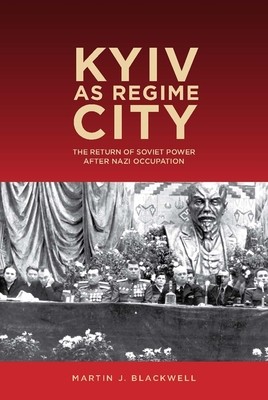
- We will send in 10–14 business days.
- Author: Martin J Blackwell
- Publisher: University of Rochester Press
- ISBN-10: 164825053X
- ISBN-13: 9781648250538
- Format: 15.2 x 22.9 x 1.4 cm, minkšti viršeliai
- Language: English
- SAVE -10% with code: EXTRA
Reviews
Description
How the Soviet Union reestablished power in a changed Kyiv following the retreat of Nazi forces, consolidating its regime as it headed into the Cold War.
Kyiv as Regime City charts the resettlement of the Ukrainian capital after Nazi occupation, focusing on the efforts of returning Soviet rulers to regain legitimacy within a Moscow-centered regime still attending to the warfront. Beginning with the Ukrainian Communists' inability to both purge their capital city of "socially dangerous" people and prevent the arrival of "unorganized" evacuees from the rear, this book chronicles how a socially and ethnically diverse milieu of Kyivans reassembled after many years of violence and terror. While the Ukrainian Communists successfully guarded entry into their privileged, elite ranks and monitored the masses' mood toward their superiors in Moscow, the party failed to conscript a labor force and rebuild housing, leading the Stalin regime to adopt new tactics to legitimize itself among the large Ukrainian and Jewish populations who once again called the city home. Drawing on sources from the once-closed central, regional, and local archives of the former Soviet Union, this study is essential reading for those seeking to understand how the Kremlin reestablished its power in Kyiv, consolidating its regime as the Cold War with the United States began.EXTRA 10 % discount with code: EXTRA
The promotion ends in 23d.14:04:03
The discount code is valid when purchasing from 10 €. Discounts do not stack.
- Author: Martin J Blackwell
- Publisher: University of Rochester Press
- ISBN-10: 164825053X
- ISBN-13: 9781648250538
- Format: 15.2 x 22.9 x 1.4 cm, minkšti viršeliai
- Language: English English
How the Soviet Union reestablished power in a changed Kyiv following the retreat of Nazi forces, consolidating its regime as it headed into the Cold War.
Kyiv as Regime City charts the resettlement of the Ukrainian capital after Nazi occupation, focusing on the efforts of returning Soviet rulers to regain legitimacy within a Moscow-centered regime still attending to the warfront. Beginning with the Ukrainian Communists' inability to both purge their capital city of "socially dangerous" people and prevent the arrival of "unorganized" evacuees from the rear, this book chronicles how a socially and ethnically diverse milieu of Kyivans reassembled after many years of violence and terror. While the Ukrainian Communists successfully guarded entry into their privileged, elite ranks and monitored the masses' mood toward their superiors in Moscow, the party failed to conscript a labor force and rebuild housing, leading the Stalin regime to adopt new tactics to legitimize itself among the large Ukrainian and Jewish populations who once again called the city home. Drawing on sources from the once-closed central, regional, and local archives of the former Soviet Union, this study is essential reading for those seeking to understand how the Kremlin reestablished its power in Kyiv, consolidating its regime as the Cold War with the United States began.

Reviews